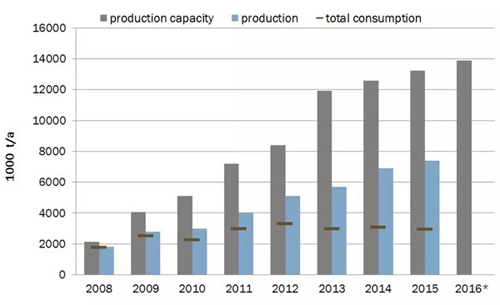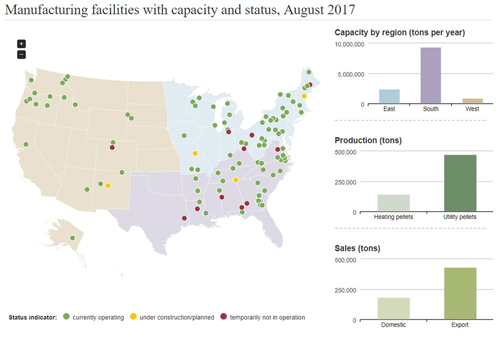Rearch shows that using wood pellet reduces greenhouse gas emissions
The latest research shows that using wood pellets for home
heating fuel reduces greenhouse gas emissions by more than half over
fossil fuels and natural gas. This research is conducted by
John Gunn from the NH Agricultural Experiment Station at the University
of New Hampshire. John Gunn is a research assistant professor of forest
management and researcher with the NH Agricultural Experiment Station.
According to Gunn’s research, there are some points as follows:
Wood pellet fuel reduces greenhouse emissions by 59% compared with natural gas, and 54% compared with home heating oil. This data strongly proofs that pellets from sawmill residues have the strongest greenhouse gas emission benefits compared to fossil fuel and natural gas.
As the largest export country of wood pellet fuel. Wood pellet fuel is a hot biomass fuel and has been proposed as a climate-beneficial energy source to replace fossil fuels in the United States. However, little effort has been tried to assess this claim. In forest region of northern Maine, New Hampshire, Vermont, and New York. There lives more than two million people in rural communities, large towns, and small cities. This area is surrounded by the largest intact forest in eastern United States, which is a large potential wood pellet market with adequate sources.
 Wood pellet production in the United States started from the
northwestern and northeastern regions, supplying regional residential
heating markets based on the small-scale production of sawmill residues.
These markets have grown year by year. Buying a biomass stove can enjoy
an allowance from the federal government, there is a biomass stove tax
credit, is a federal incentive to receive a tax credit of $ 300 by
December 31, 2016 for the purchase of wood pellet fuel or wood pellet
stoves.
Wood pellet production in the United States started from the
northwestern and northeastern regions, supplying regional residential
heating markets based on the small-scale production of sawmill residues.
These markets have grown year by year. Buying a biomass stove can enjoy
an allowance from the federal government, there is a biomass stove tax
credit, is a federal incentive to receive a tax credit of $ 300 by
December 31, 2016 for the purchase of wood pellet fuel or wood pellet
stoves.
With the new Highland Pellets plants put into use in Pine Bluff and Alaska, the US pellet industry has achieved 13.7 Mt of capacity by the end of 2016. Most plants which produce sawdust pellets operating capacity reached 13.2Mt. Sawdust pellet production has shown steady growth since 2004. Since 2005, 16 new pellet plants have been built in the southern United States.
63% of total US production in 2015 was for exports, of which 99% were exported to the EU market. Therefore, the EU is mainly used in the industrial market. The rest of the production share is mainly for the domestic market, while in this market is mainly for residential heating. It is estimated that more than 13 million wood heaters are put into operation in the United States.

According to Gunn’s research, there are some points as follows:
Wood pellet fuel reduces greenhouse emissions by 59% compared with natural gas, and 54% compared with home heating oil. This data strongly proofs that pellets from sawmill residues have the strongest greenhouse gas emission benefits compared to fossil fuel and natural gas.
As the largest export country of wood pellet fuel. Wood pellet fuel is a hot biomass fuel and has been proposed as a climate-beneficial energy source to replace fossil fuels in the United States. However, little effort has been tried to assess this claim. In forest region of northern Maine, New Hampshire, Vermont, and New York. There lives more than two million people in rural communities, large towns, and small cities. This area is surrounded by the largest intact forest in eastern United States, which is a large potential wood pellet market with adequate sources.

With the new Highland Pellets plants put into use in Pine Bluff and Alaska, the US pellet industry has achieved 13.7 Mt of capacity by the end of 2016. Most plants which produce sawdust pellets operating capacity reached 13.2Mt. Sawdust pellet production has shown steady growth since 2004. Since 2005, 16 new pellet plants have been built in the southern United States.
63% of total US production in 2015 was for exports, of which 99% were exported to the EU market. Therefore, the EU is mainly used in the industrial market. The rest of the production share is mainly for the domestic market, while in this market is mainly for residential heating. It is estimated that more than 13 million wood heaters are put into operation in the United States.

Advantages of wood pellets are summarized below:
- Little flying ash. Generally, the wood dust is no more than 3%(except for rice husks, etc.). simplifies the ash dealing device of the burning equipment.
- Wood pellet fuel during the process of burning produce little smoke, no black smoke.
- Wood pellet fuel usually doesn’t have effection on the natural circulation of carbon in nature.
- Sawdust itself contains less Nitrogen than coal, which reduces the formation of Nitrogen oxides.
- Sulfur oxide emissions are lower during combustion. The sulfur content of sawdust is generally less than 0.1%. Flue gas desulfurization device is not needed, helps reducing the cost and benefiting the environment protection.
- Reduce emissions of heavy metal pollutants. Studies have shown that coal contains many trace elements, such as: As, Hg, V, Pb, Zn, Se, Co, Ni, Cr, many of which are toxic and harmful heavy metal elements. The basic sawdust does not contain heavy metals.
- Wood chips are rich in resources and prices are especially low. With wood chips for fuel reduces the cost of raw materials.
- Wood pellets can burn fully, reduce the waste of incomplete combustion caused.





Comments (2)
Simran Sharma
1
Simranindependentescort
Best is the hottest Kolkata escort 09821961695 who offer 24/7 escorts service in Kolkata to those guys who are looking for new partner or single.